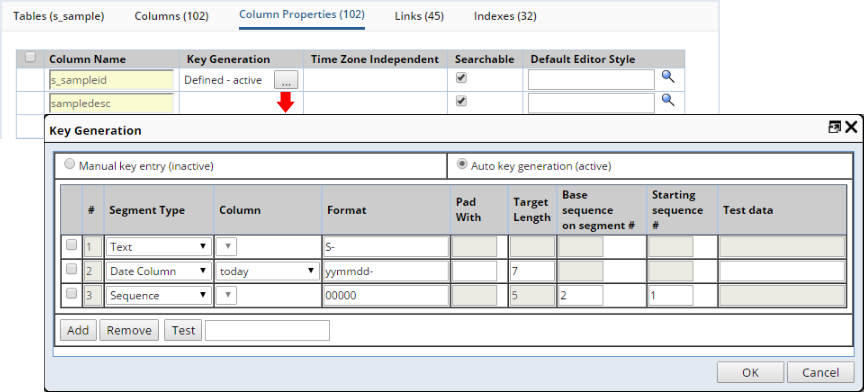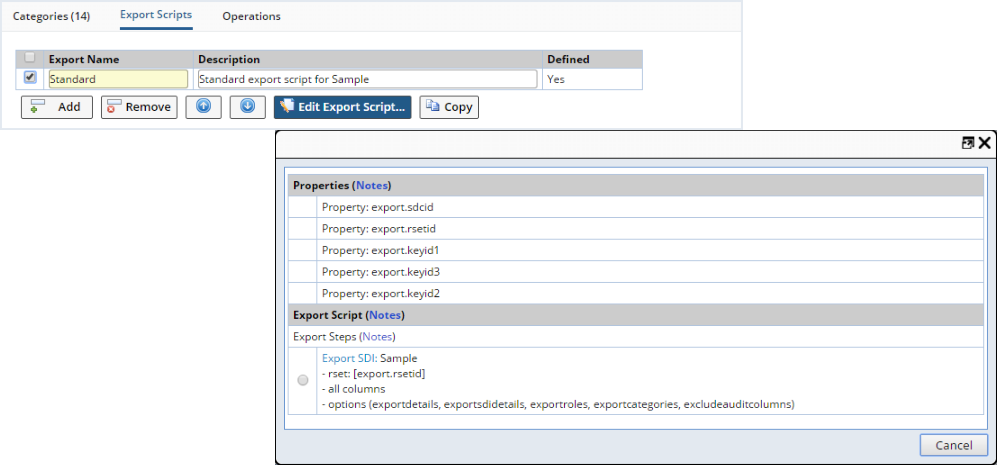Manage and maintain:
| • |
SDC primary information such as naming conventions, security, auditing,
and behavioral attributes. |
| • |
SDC primary and detail tables. |
| • |
SDC column maintenance to the level of extended properties, links, and
indexes. |
| • |
SDC support functions such as export definitions and Departmental Security
operations. |
The SDC tab group manages SDC primary information such as naming conventions,
security, auditing, and behavioral attributes.

|

|
| Option |
Description |
| Access
Control |
Lets you apply Role-Level Access or Departmental Security
(see Concepts of LabVantage
Security):
| Option | Description | | Open Role | If you do not give any Roles access to the SDI,
LabVantage assumes that there is no intent to restrict the SDC.
Accordingly, all Users will have access to all existing and newly-created
SDIs in the SDC. | | Restrictive Role | If you do not give any Roles access to the SDI,
you will not be able to access any existing or new SDIs in the SDC. | | Departmental | Implements Departmental
Security for the SDC. | | SDI Security | Implements SDI
Security for the SDC. This displays an option to select a "Default
Security Set" to use for the SDC. | | Not Implemented | Disables Role-Level Access control for the SDC. |
This specialized option is available only for the DataSet SDC: These specialized options are available only for the SDIWorkitem SDC: |
| Allow Chain of Custody |
Establishes and documents ownership and location of an
SDI, providing the ability to create a chain for all SDIs in that SDC.
Custodian is an SDC to which you can add Custodians (SDIs) that will
accept and relinquish custody within the COC. When you accept
custody of an SDI, you must identify both yourself and the Custodian
from whom you received the SDI. When you relinquish custody, you
must identify both yourself and the Custodian to whom you are transferring
the SDI. You can also require that Custodians enter a password
prior to accepting or relinquishing custody. For each transfer
of custody, there is only one relinquisher and one acceptor. |
| Audit Method
Audit Prompt Options Reason Reference Type |
Records all changes made to each SDI (see Concepts
of Auditing).
Although these properties are honored by all pages, the preferred method
is to configure ESig options for the page. | Audit Reason | Functionality | | None | Disables Auditing. | | Background | Automatically and continuously records changes. | | Prompt | Records changes only after prompting you. | | Prompt with Password | Records changes only after you enter a password. |
| Audit Prompt Options | | | Standard Reason Required | You must choose a Standard Reason for
the change. Standard Reasons are Reference Types. You must therefore
choose a Reference Type from the "Reason Reference Type" drop-list
(or create your own). | | Free Text Reason Required | You must enter a Reason (in your own
words) for the change. | | Standard Reason Optional | Allows (but does not require) you to
choose a Standard Reason for the change. | | Optional Reason | Allows (but does not require) you to
enter a Reason (in your own words) for the change. | | Free Text or Optional
Reason | Allows (but does not require) you to
either enter a Reason in your own words or choose a Standard Reason. | | Text or Reason | You must either enter a Reason in your
own words or choose a Standard Reason. |
|
| Change Control |
Determines whether or not this SDC will be under Change Control when Change Control is enabled.
| Option | Description | | No | This SDC is not under Change Control. | | Under Parent Change Control | This SDC depends on its parent to track changes. For example, when changes are made to Product Variants listed on a Product SDI only the Product (parent) is checked out. A Change Log is generated for the Product only. | | Yes | Turn Change Control on for this SDC (when Change Control is enabled in the CMT Policy). | | Template Only | Only Template SDIs are under Change Control for this SDC. In cases such as Samples you might not want to control and track each change made to individual Sample SDIs. However, you would want to track changes made to a Sample Template. |
|
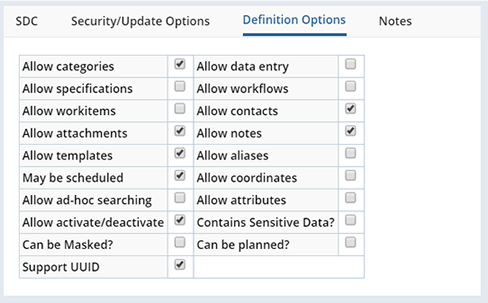
|
| Option to Allow... |
Description |
| Allow Adhoc Searching |
Makes SDC searchable. This used when creating Adhoc
Queries. |
| Allow Aliases |
Identifies an SDI by one or more names ("aliases") other
than the SDI Id. Example:
| Alias Type | Name | | Formal | John Drake, M.D., F.A.C.S. | | Colloquial | J.D. | | Correspondence | J. Drake, M.D. |
Aliases are defined by a Reference Type called "Alias Type", for which
you enter one or more classifications (arbitrary names) that could define
an alias. For example, if you are creating aliases for Users and Customers,
a User classification could be Colloquial (see example above), while
a Customer classification could be Formal. |
| Allow Activate/Deactivate |
Allows SDIs to be declared as "Active" (in use)
or "Inactive" (no longer in use). See Active
and Inactive SDIs. |
| Allow Attachments |
Allows file Attachments to be added to SDIs. |
| Allow Attributes |
Allows Attributes to be added to SDIs (see Attributes). |
| Allow Categories |
See Categories below. |
| Allow Contacts |
A Contact is a business or person defined by an Address
SDI, which contains personal contact and mailing address information for
a Contact. This option allows associating a Contact with SDIs. |
| Allow Coordinates |
Allows use of the Map Interface. |
| Allow Data Entry |
Allows addition of Data Sets to SDIs. You must do this
in order to enter data for the SDIs.
See Concepts of Parameter
Lists for information concerning Data Sets. |
| Allow Notes |
Allows adding a textarea for notes regarding the SDI. |
| Allow Specifications |
Allows Specifications to be added to SDIs (see Concepts
of Specifications). |
| Allow Templates |
Allows creation of SDI Templates.
An SDI Template is a copy of an SDI and all information associated
with it. For example, an SDI Template made from this Sample would include
the associated Data Sets and Specifications: | 
| Data
Sets | | | | |
| 
| 
| Metals;1;2;1;1 | | | |
| 
| 
| Polymers;1;3;1;1 | | | |
| 
| Specifications | | | | |
| | 
| Process;1;2 | | | |
| | 
| Production;1;2 | | | |
|
| Allow WorkItems |
Allows WorkItems to be associated with SDIs (see Adding
and Maintaining Tests). |
| Can be Masked? |
Allows the SDC to be masked (see Data
Masking). |
| Can be Planned? |
Makes the SDI Plannable (see Introduction
to Work Assignment and Planning). |
| Contains Sensitive Data? |
Indicates that the SDC contains sensitive information
(see Data Masking). |
| May Be Scheduled |
Allows SDIs to be used as Sources for Plan Items in the
Scheduler. |
| Support UUID? |
When checked, a UUID (universally unique identifier) must be generated for any SDI Exported using the Configuration Management Transfer Tool (CMT) (See CMT Transfer). |
Text area to accommodate a lengthy description of the SDC.
The Tables tab group is a detail element that lets you manage and maintain
SDC primary and detail tables. Column maintenance is also provided down to
the level of extended properties, links, and indexes.
The Tables tab shows all SDC tables. Clicking a table highlights it, shows
the table name in the tab, and populates the other tabs with details
for that table.
| Field |
Description |
| Table |
Table defined within the SDC. This shows detail tables
(LinkType = D in the SDCLink table) and many to many tables (LinkType
= M in the SDCLink table). |
| Relation |
Relationship of the table to the primary table. |
| Parent |
Parent table of the detail table. |
| Type |
Type of SDC (see Concepts
of SDCs, SDIs, and Reference Types). |
| Link Id |
Value of the LinkId column in the SDCLink table. |
| Table Label |
When displayed in an SDI Snapshot use this label to identify this SDC table. |
| Item Display Format |
When displaying table data in an SDI Snapshot, use this format for column titles.
See Configuring CMT for more information. |
| Button |
Description |
| Add |
Adds a new detail table:
| • | OK forces a save of all SDC changes. | | • | The system provides the parent table keys automatically. | | • | New tables have the default SDC detail table columns defined.
| | • | You must add any detail table keys required to make each row unique. |
|
| Remove |
Deletes the selected detail tables:
| • | You cannot delete System detail tables. | | • | As is the case with adding tables, OK forces a save of all SDC
changes. | | • | You cannot delete the Primary table. | | | |
|
For the currently selected table in the Table tab, the Columns tab shows
all columns along with their types, lengths and link status.
| • |
For System and Core columns, only the Description column can be modified. |
| • |
For user-defined columns, the Length column can be modified. |
| Field |
Description |
| Column Name |
Prior to choosing a name (identifier) for an SDC column,
see the SDI Column Naming Restrictions
in the topic Standards and References.
|
| Description |
Text description of the column data. |
| Data Type |
Defines the data storage format:
| Data Type | Description | | Character | Character string.
| NOTE: | | Under certain circumstances, when a field has no value but the database column cannot be empty, a character string is stored as '(null)'. This can happen when multi-keyed SDCs have columns for keyid2 and keyid3 but these columns are not used. |
| | Number
Decimal | These LabVantage Data Types correspond to the following
numeric data types defined by the DBMS in use:
| LabVantage Data Type | Description | Oracle Data Type | SQL Server Data Type | | Number | Defines an integer. | NUMBER | NUMERIC(18,0) | | Decimal | Defines a real number. | NUMBER | NUMERIC(28,10) |
| | Date | Date/time values. | | BLOB | Binary Large Object (unstructured binary data). | | CLOB | Character Large Object (character set data). |
|
| Length |
Number of characters in the varchar string. When adding
columns, you can increase length if your database allows such an operation. |
 |
Indicates that column is linked to another SDC or a Reference
Type. |
 |
Indicates that the column can be linked to another SDC
or a Reference Type, but is not currently linked.
Click this icon to add a foreign key link for the column. |
| Button |
Description |
| Add |
Adds a new user-defined column. |
| Remove |
Deletes selected columns.
Only user-defined columns can be deleted. |
|

|
|
If you add/delete columns
to/from any table on which a view is based (such as s_sample and
study), you must refresh the view.
LabVantage creates views using these scripts: | • | Oracle
LABVANTAGE_HOME\install\database\ora_udmviews.sql | | • | MS SQL Server
LABVANTAGE_HOME\install\database\mss_udmviews.sql |
Run the relevant script to refresh the view. |
|
Some SDC columns have "extended properties" (meaning you can modify them).
You can change them here. These properties are held in the SysColumnProperties
table.
| Field |
Description |
| Column Name |
Identifier of the column. |
| Key Generation |
Click the ellipsis button to open the Key
Generation feature to automatically assign identifiers to new SDIs.
Key columns can have a key generation rule defined using the same key
generation editor available for the primary table. |
| Time Zone Independent |
Some Date columns can be formatted as "Date-with-Time"
or "Date-Only". "Date-Only Columns" are referred to here as "Time Zone
Independent". Choose "Yes" for "Date-Only", "No" for "Date-with-Time".
Timezone-independent date columns are not translated when rendering
dates in a browser from a server in a different time zone. |
| Searchable |
Makes the column searchable. This is used when creating
Adhoc Queries. |
| Default Editor Style |
Editor Style
used to render data for this column. |
The Links tab shows links for the columns of the currently selected table
in the Table tab. This lets you create links to other SDCs and Reference Types.

|
| Field |
Description |
| Link Type |
Defines the set of columns that are enabled in each row.
See Link Types for descriptions. Notes: | • | Link Ids are automatically created. | | • | Two columns can be defined in a foreign key kink (typically the
identifier and the version). | | • | Many to many links can be defined only on the primary table of
the SDC. |
|
| Link Col 1
Link Col 2 Linked SDC Linked RefType |
Used to create links. See Linking
Procedure for instructions. |
| Link Table |
The link table is not editable. It is defined by the system. |
| Delete Rule
|
Defines behavior when the parent SDC of the foreign
key link is deleted.
In the example screen above, the Param SDC is linked to the ParamList
SDC. If a Param SDI is deleted and it exists in a ParamList, the Delete
Rule comes into play: | • | "Block" will prevent the Param delete. | | • | "Delete" will delete the ParamLists where the Param occurs. | | • | "Null Out" will null out the column value in the ParamList table
where the Param occurs. An error is thrown if this column is a key
column. | | • | "Default" is equivalent to "Null Out" for backward-compatibility. |
|
This is a one-to-many relationship, linking the foreign key column to all
SDIs in the SDC with the primary key.
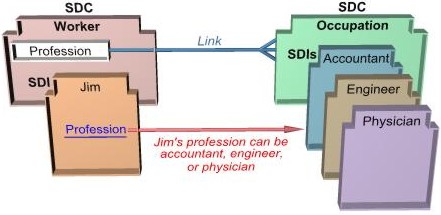
| a. |
Create an SDC called Worker. Add a column called Profession. |
| b. |
Link the Profession column to another SDC called Occupation. Create
the Occupation SDIs Accountant, Engineer, and Physician. The Worker's
Profession can now be any one of these SDIs. |
| c. |
Add an SDI called Jim to the Worker SDC. |
| d. |
Jim is now linked to all Occupation SDIs. Since the Profession
column is linked to the Occupation SDC, available values for Jim's Profession
are Accountant, Engineer, and Physician. |
| Reference
Link and Reference Validated Link
|
Both of these link an SDC column to a Reference Type. Both allow selection
of a value defined by the Reference Type. The difference:
| • |
Reference Link lets you select values defined by a Reference Type, or
enter any other value. |
| • |
Reference Validated Link lets you select only values defined by a Reference
Type. |
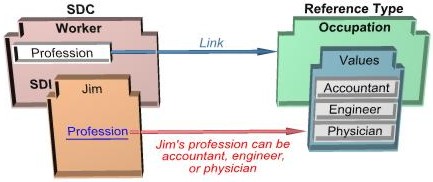
| a. |
Create an SDC called Worker. Add a column called Profession. |
| b. |
Link the Profession column to a Reference Type called Occupation. In
the Reference Type, define the values Accountant, Engineer, and Physician.
The Worker's Profession can now be any one of these values. |
| c. |
Add an SDI called Jim to the Worker SDC. |
| d. |
Jim is now linked to all values defined by the Reference Type.
Since the Profession column is linked to the Reference Type, available
values for Jim's Profession are Accountant, Engineer, and Physician. |
A Many-to-Many Link links all SDIs in an SDC to all SDIs in another SDC.
| Example Many-to-Many Link
|
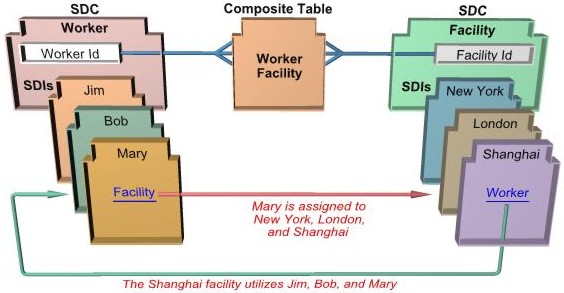
Suppose you want to assign three Workers to three
Facilities. A Many-to-Many Link can accomplish this by associating one
Worker with multiple Facilities, and one Facility with multiple Workers.
LabVantage automatically generates the composite table that makes the association
possible.
| a. |
Create an SDC called Worker. Add three SDIs called Jim, Bob, and Mary. |
| b. |
Create an SDC called Facility. Add three SDIs called New York, London,
and Shanghai. |
| c. |
In the Worker SDC, link the WorkerId column to the Facility SDC. |
| d. |
In the Facility SDC, link the Facility Id column to the Worker SDC. |
| e. |
Each Worker SDI is now linked to all three Facility SDIs, and each Facility
SDI is now linked to all three Worker SDIs. For example, all Facilities
are associated with Mary, and the Shanghai facility is associated with
all three Workers. |
| Foreign
Key Link (single foreign-key column)
|
| a. |
For the Link Type, choose Foreign Key. |
| b. |
For the Link Col 1, choose the (foreign key) column to be linked
to the SDC with the primary key. |
| c. |
For the Linked SDC, choose the SDC to which the (foreign
key) column will be linked. |
| d. |
Choose the Delete Rule for the link. |
| Foreign
Key Link (dual foreign-key columns)
|
| a. |
For the Link Type, choose Foreign Key. |
| b. |
For the Link Col 1, choose the first (foreign key) column to be
linked to one of the primary keys in the SDC to which you are linking. |
| c. |
For the Link Col 2, choose the second (foreign key) column to be
linked to the other primary key in the SDC to which you are linking. |
| d. |
For the Linked SDC, choose the SDC to which the (foreign
key) columns will be linked. |
| e. |
Choose the Delete Rule for the link. |
| a. |
For the Link Type, choose Many to Many. |
| b. |
For the Linked SDC, choose the SDC to which the current
SDC will be linked. |
Reference
Link and
Reference (Validated) Link |
| a. |
For the Link Type, choose Reference or Reference (Validated),
as applicable. |
| b. |
For the Link Col 1, choose the column to be linked to
the Reference Type. |
| c. |
For the Reference Type, choose the Reference Type to
which the link is to be made. |
When Auto Key Generation is selected, the Key Generation feature automatically
assigns the identifier (primary key) to each new SDI. Access "Key Generation"
from the "Column Properties". Use the following information to specify
the sequence of characters used to generate the key.
A Segment defines rules for generating the key. In
general, you can:
| • |
Use a single Segment to define a single key. |
| • |
Append multiple Segments to define portions of a single key. In this
case, the key consists of all Segments from top to bottom. |
Click Add to create a Segment. To change their order,
select a Segment, then use the up and down arrows.
A Segment Type defines the key's data type and display format, as well as
the numeric sequence used to generate the key. The following definitions and
examples show their use.
| #
|
Segment
Type
|
Column
|
Format
|
Pad
With
|
Max
Length
|
Base on
Segment #
|
Starting
Sequence #
|
Test Data
|
| 1 |
Text |
|
widget |
|
|
|
|
|
| 2 |
Sequence |
|
333# |
|
|
0 |
1 |
|
| 3 |
String Column |
chemical |
First n Char |
_ |
5 |
|
|
|
| 4 |
Date Column |
createdt |
yymmdd |
|
5 |
|
|
|
| 5 |
Numb Column |
auditseq |
change# |
|
5 |
|
|
|
| Segment Type |
Description |
| Text |
Generates a character string. Enter a series of
contiguous characters for the Format.
In the example above, the Segment would appear as widget. |
| Sequence |
Generates a sequentially-incremented character set. This
uses the # (automatically generated Segment Number), which
you use to identify the order of the Segments. Here are two examples.
If you want to define the
entire sequence independent of any other Segment: | a. | For the Format, enter a series of contiguous
characters, then enter a # (pound sign) where you
want the sequentially-incremented number to appear in the character
string. | | b. | Enter 0 (zero) for the Base on Segment Number. | | c. | For the Starting Sequence #, enter the first
number in the sequence that will appear in place of the pound sign. |
In the example above, the Segment would appear
for each SDI as the sequence 3331, 3332, 3333, . . . , 333n. If you want to define the
sequence based on another Segment: | a. | For the Format, enter a # (pound
sign). | | b. | For the Base on Segment #, enter the Segment
Number containing the Segment that will preface the sequentially-incremented
number represented by the pound sign. |
|
| String Column |
Generates a portion of the column identifier specified
by Column:
| a. | Choose the Column you wish to use as the Segment. | | b. | For the Format, choose whether to use the First
n or Last n Characters
from the Column. If you wish to insert another character before
or after the Segment, enter it for the Pad With. |
In the example above, the Segment would appear as chem_.
The First n Characters were chem because, with the underscore, the Maximum
Length of 5 characters was reached. If you specified the Last
n Characters, the Segment would appear as _ical. |
| Date Column
|
Generates a date specified by Column:
| a. | Choose the Column (containing date information)
that will appear as the Segment. | | b. | For the Format, choose the date format. |
For Date Columns, you can also define a key that indicates the day
of the year. The example below generates a key sequence of S-001 through
S-nnn, where nnn is the last day of the year (such as S-001 for 01-Jan
through S-365 for 31-Dec in a non-leap year). Note that: | • | Format must be doy. | | • | Target Length indicates the string length. | | • | Pad With inserts the padding character for the Target Length. |
|
| Number Column |
Generates a sequentially-incremented character set, with
the sequence number extracted from the Column:
| a. | Choose the Column from which the sequentially-incremented
number will be extracted. | | b. | For the Format, enter a series of contiguous
characters, then enter a # (pound sign) where you
want the sequentially-incremented number to appear in the character
string. |
In the example above, the Segment would appear for each SDI as change(auditseqn),
where (auditseqn) is the current Audit Sequence number from the auditseq
column. |
| Max Length |
Maximum number of characters in the Segment. This is
available only if String, Date, or Number columns are part of the segment. |
| Test |
You can see how your key will appear by entering a text
string in the input field, then clicking the Test button. |
|
NOTE:
|
If you create an Automatic Key Generation sequence that is based
on more than one column, the key will contain the contents of each
column specified in each segment.
For example, consider a Sample SDC with two user-added columns.
One column has an SDC Link to the Company SDC, while the other column
has an SDC Link to the Material SDC. You could generate a sequence
based on both the Company and Material columns. Suppose the
Company SDIs are:
COMPA, COMPB
...and the Material SDIs are:
MATA, MATB
Your sequence could then be:
S_COMPA_MATA_001, S_COMPA_MATA_002, S_COMPA_MATB_001,
S_COMPB_MATB_001, S_COMPB_MATA_001
|
The Indexes tab shows the indexes of the currently selected table in the "Tables"
tab. Indexes deleted that are defined as part of the LabVantage installation
will be recreated during an upgrade.
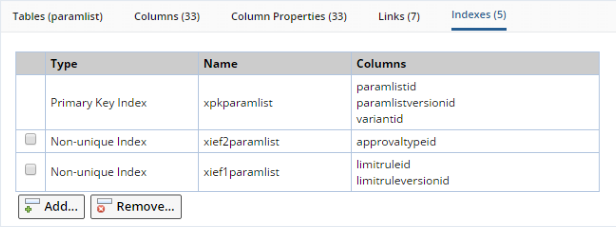
|
|
NOTE:
|
If using a SQL Server DBMS, be advised that support for unique indexes
in SQL Server has historically resulted in the re-routing of all unique
indexes to non-unique indexes. The primary difficulty is that SQL Server
treats (null) as empty string values as part of the uniqueness, thus necessitating
the indexed column to be NOT NULL.
To resolve these issues, creation of unique indexes in SQL Server is
supported in the "Indexes" detail tab. The behavior of unique
index creation is described below:
| • |
When a new LabVantage installation is performed, OOB indexes that
are unique are created as unique (such as SDIKeyId indexes in SDIData
and SDIDataItem). |
| • |
When a LabVantage upgrade is performed, existing indexes that are
unique OOB but have been created as non-unique in the previous (pre-upgrade)
LabVantage installation are left as non-unique (such as SDIKeyId indexes
in SDIData and SDIDataItem). |
| • |
In the "Indexes" detail tab:
| • | When adding a unique index to a table containing no data,
the index is created as unique. | | • | When adding a unique index to a table containing data but
the column to be indexed is not populated in any row, the index
is created as unique. | | • | When adding a unique index to a table containing data but
the column to be indexed is populated with unique data, the
index is created as unique. | | • | When adding a unique index to a table containing data but
the column to be indexed is populated with non-unique data,
the index is created as non-unique. |
|
| • |
When adding a SysConfig record of PropertyId = 'UniqueIndexAction'
with propertyvalue = 'E', then adding a unique index to a table containing
data but the column to be indexed is populated with non-unique data,
an error is thrown due to attempting to create a unique index when
non-unique data exists. Otherwise, it will continue to create the
index as non-unique. |
|
Categories are logical groups within the SDC. Each Category can contain related
SDIs.
For example, Samples allocated for test, research, and production can be arranged
like this:
| SDC |
Categories |
SDIs |
| Sample |
Test |
S-070207-00001
S-070207-00002
S-070207-00003 |
| Research |
S-070110-00001
S-070120-00005
S-070207-00009 |
| Production |
S-070114-00002
S-070201-00004
S-070205-00007 |
The "Exports" detail defines the "Standard Export Script"
that is offered when exporting SDIs using the Configuration Transfer Tools (see
Configuration Transfer Tools →
Exporting SDIs → Export SDI Wizard Detail → Set Export Options).
Core and System SDCs provide a non-editable script. An editable script is automatically
generated for User SDCs, and can be modified using "Edit Export Script".
The defines SDC Operations for Departmental Security (see Concepts
of LabVantage Security).
















